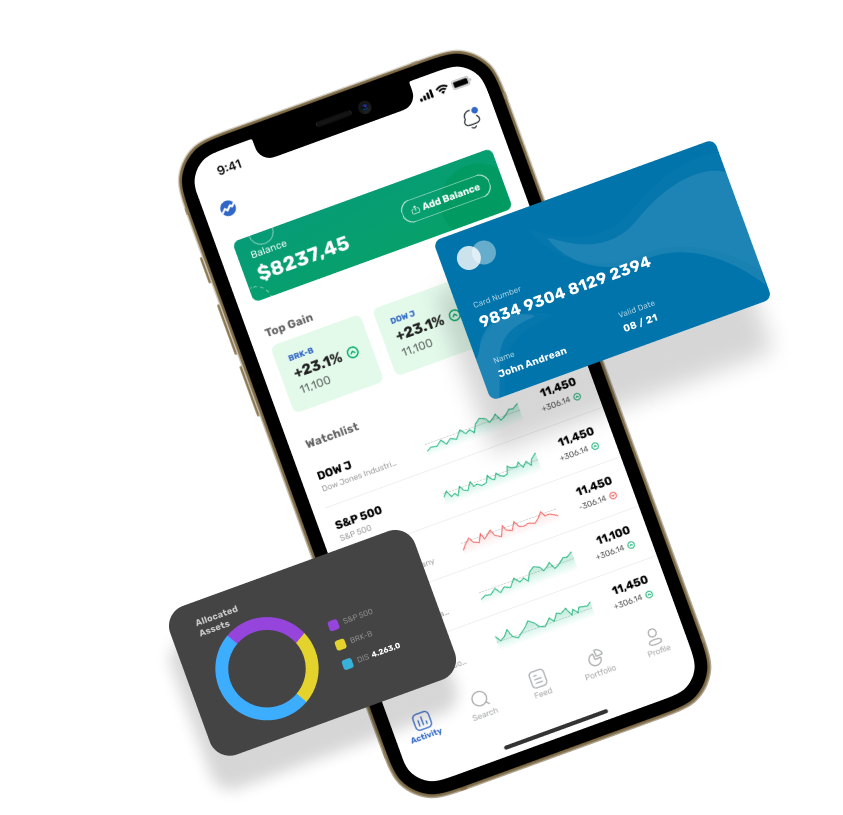20 Best Reasons For Deciding On AI Stock Prediction Websites
20 Best Reasons For Deciding On AI Stock Prediction Websites
Blog Article
Top 10 Tips On Assessing The User Interface And Experience Of Ai Platforms For Stock Prediction And Analysis.
The User Interface and User Experience of AI trading platforms that use stock prediction/analysis are critical for ensuring efficiency and usability. They also contribute to general satisfaction. A poorly designed interface can hinder decision-making, even if the underlying AI models are robust. Here are 10 top tips to evaluate the user interface on these platforms.
1. Evaluation of the intuitiveness and ease of use
Navigation: Make sure the platform is easy to use, with menus and buttons that are easy to understand as well as workflows.
Learning curve: Measure how fast an individual can learn and use a system without extensive instruction.
Consistency - Examine the patterns of design across all platforms to ensure consistency (e.g. buttons, colors styles, colors).
2. Make sure you check for customizability.
Dashboard customization: Determine whether the dashboard is customized to display pertinent metrics chart, data, or charts.
Layout flexibility: Ensure your platform permits you to reorder widgets, charts and tables.
Make sure to check the platform's dark and light options, or your visual preferences.
3. Visualize Data
Quality of the chart. Check that your platform provides top-quality interactive charts (e.g. Candlestick charts or Line charts) with zooming/panning functionality.
Visual clarity: Make sure that the data is clearly displayed, with proper labels, legends, tooltips and more.
Real-time updates: Make sure that the visualizations are updated in real time to reflect the latest developments on the market.
4. Test Speed and Reactivity
Speed of loading: Ensure that the platform is loaded quickly regardless of handling huge data sets or complex calculations.
Real-time performance: Check whether the platform is able to manage real-time feeds of data, without delays or lags.
Cross-device compatibility: Make sure whether your device can be used on every device (desktops and mobiles, as well as tablets).
5. Assess the accessibility
Go through the mobile app to see if it offers all of the features that you require for on-the go trading.
Keyboard shortcuts - Make sure the platform has keyboard shortcuts available for power users.
Accessibility features. Check the platform's conformity to accessibility standards.
6. You can sort and search your results.
Search efficiency: Ensure that the platform lets users swiftly search for indexes, stocks or other assets.
Advanced filters: Determine if the user can apply filters to achieve specific results (e.g. by sector, capitalization, or performance metrics).
Saved search: Verify whether the platform permits users to save frequently used searches and filters.
7. Be sure to check for alerts and notifications.
Customizable Alerts: Users are able to make alerts that are based on specific conditions, such as price thresholds, spikes in volume, and news happenings.
Notification Delivery: Check to see if notifications are delivered in a variety of ways (e.g. via email, SMS or app notifications).
Timing: Check if alarms are activated quickly and accurately.
8. Connect to other tools
Broker integration: Make sure that the platform is integrated seamlessly with your brokerage account to allow ease of trade execution.
API access. Find out if the platform provides API access to advanced users to create custom workflows and tools.
Third-party Integrations: Ensure the compatibility of your platform with the other programs (e.g. Excel, Google Sheets and trading bots).
9. Assessment Help and Support Features
Onboarding Tutorials: Verify whether your platform provides tutorials or guides to new users.
Help center: Ensure that the platform provides a comprehensive knowledge base or help center.
Customer support: Check whether there is a quick customer service (e.g. chat on the internet, email or phone).
10. Test User Experience Overall
User feedback: Reviews and testimonials are used to gauge the overall satisfaction of the users with the platform's UI/UX.
Trial period: Make use of a free demo or trial period to assess the platform's usability.
Error handling: Check how the platform handles errors and edge situations (e.g., invalid inputs and server downtime).
Bonus Tips
Aesthetics. Functionality is essential, but a visually appealing layout can boost the experience of users.
Performance under pressure Test the platform under volatile market conditions to make sure it remains solid and flexible.
Look for forums that are active and communities. Users are able to share their experiences and tips in these communities.
Utilize these guidelines and you will be able to evaluate the UX/UI of AI-powered stock prediction/analysis trading platforms. They will be user-friendly, efficient, as well as aligned your needs in trading. A great UI/UX is an extremely effective tool that can aid you in making better decisions and make better trades. Check out the recommended do you agree for AI stock market for blog recommendations including ai investment platform, AI stocks, best AI stock trading bot free, AI stock market, trading ai, AI stock picker, investment ai, trading with ai, investing ai, ai trading and more.
Top 10 Tips For Evaluating The Regulatory Compliance Of Ai Stock Prediction/Analyzing Trading Platforms
Compliance with regulations is an essential factor in evaluating trading platforms that use AI. Compliance helps to ensure that the platform operates within the legal frameworks and safeguarding user data. Here are 10 top ways to evaluate the compliance with regulations of these platforms:
1. Verify the licensing and registration
Regulatory authorities: Check that the license and registration is with the appropriate financial regulators (e.g. SEC or FCA in USA, ASIC or ASIC in Australia).
Verify the broker collaboration If your platform has a partnership with brokers or brokers, make sure that these brokers are licensed and regulated.
Public records: You can check the official website of the body that regulates it to determine if the platform is registered and if there has been any violations in the past.
2. Compliance with the Data Privacy Assessment
GDPR If a platform is operating within the EU or offering services to customers in the EU the platform must comply with the General Data Protection Regulation.
CCPA : California Consumer Privacy Act (CCPA) compliance must be checked by the users.
Data handling Policies: Read the policy of the platform on privacy and data security to ensure that it clarifies exactly what data users' information is stored, used and shared.
3. Evaluating Anti-Money Laundering / AML Measures
AML policies: Ensure that your platform is equipped with robust AML policy that can detect and prevent any money laundering.
KYC procedures - Check that the platform adheres to Know Your Customer procedures for authenticating user identities.
Monitoring transactions: Find out if the platform monitors transactions for suspicious activity, and then reports it to the appropriate authorities.
4. Make sure that you are in compliance to Trading Regulations
Market manipulation: Make sure that the platform has measures in place to prevent manipulating the market, for example, spoofing and wash trading.
Types of orders. Verify that the platform conforms to all regulations regarding order type (e.g. there isn't any illegal stop loss hunting).
Best execution : Ensure that the platform is using top execution methods to make trades at the lowest price.
5. Cybersecurity Compliance:
Data encryption - Ensure that the platform uses encryption to protect data while in transit or at the rest.
Incident response: Verify that the platform has a crisis response plan in place to deal with cyber-attacks or data breaches.
Certifications - Find out whether your platform is certified. cybersecurity certifications.
6. Review Transparency and Transparency
Fee disclosure: Ensure that the platform clearly outlines any fees, extra or hidden charges.
Risk disclosure: Make sure the platform has clear information on risk. This is particularly important for trading strategies with high leverage or risk.
Performance reporting: Make sure the AI platform is transparent and provides exact performance information to its AI model.
7. Make sure that the product is in compliance with International Regulations
Trading across borders If you're trading internationally, ensure that the platform you are using is in compliance with all applicable regulations.
Tax reporting: Verify whether there are any reports or tools to help you comply with the tax regulations.
Sanctions compliance - Make sure that the platform is compliant to international sanctions and does not allow trading only with countries or entities prohibited.
8. Reviewing Audit trail trails and Record-Keeping
Transaction records: To meet regulatory and auditing reasons, ensure that the platform maintains detailed logs of all transactions.
Logs of activity for users: Determine if the platform logs users' activities, including trading, logins, as well as modifications to account settings.
Audit-readiness: Determine whether the platform will be capable of generating all the required documentation and logs for the possibility of a regulatory audit.
9. Verify compliance with AI-specific regulations.
Algorithmic trading regulations: If the platform is able to support algorithmic trading, ensure it's in compliance with regulations such as MiFID II in Europe or Reg SCI in the U.S.
Fairness and Bias: Check to see if there are any biases the platform can detect and reduce within its AI model. This will ensure fair and ethical trade.
Explainability: Make sure the platform provides clear explanations for AI-driven decisions and predictions, as required by some rules.
10. Review User Commentaries and Regulatory Historical The History
Reviewer feedback: Go through the feedback of users and then compare it with the platform's the regulations.
History of regulation: Determine whether the platform has any history of regulatory violations such as fines, penalties, or sanctions.
Third-party auditors: Make sure that the platform is audited regularly by a third party to ensure it's adhering to rules and regulations.
Bonus Tips
Legal consultation: Consult an expert in the field to check whether your website is compliant with the regulations.
Free trial period: You are able to avail a demo or a free trial to test the features that ensure compliance of the platform and its documentation.
Customer support: Make sure the platform offers support for questions or issues related to compliance.
Use these guidelines to assess the regulatory compliance and protection of your interests. Compliance does more than reduce legal risks, but also improves confidence in the platform. Have a look at the top AI stock price prediction for blog tips including chart analysis ai, free ai tool for stock market india, best AI stock prediction, AI stock analysis, ai share trading, ai software stocks, how to use ai for copyright trading, chart ai trading, best ai for stock trading, chart analysis ai and more.